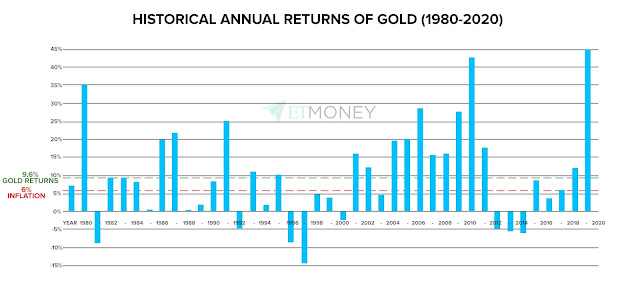Investment in gold is a good option if you have dead income & you are planning to invest in some other division to make your portfolio more diversified. In one of my previous blogs, I told you, 3 reasons why to do investment in gold.?. Once you plan to invest in gold, the next question will appear, i.e which options will be profitable for gold investment.
Because normal people tendency is, they purchase gold in
form of bars, coins, jewellery or purchase gold certificate from a certified
seller. Now the scenario has changed. The investor has In many other options are
available for gold investment.
In this blog, I’ll give you through comparison between each option,
which give you better clarity about the investment of gold.
Let first understand the options available for investors.
- Physical gold
- Gold ETF (Exchange-traded funds)
- Gold Mutual Fund
- Sovereign gold bonds
- Digital gold
|
Sr.No |
Factors |
Physical Gold |
Gold ETF |
Gold Mutual Fund |
Digital Gold |
Sovereign Gold
Bonds
|
|
1 |
Charges (calculate %
w.r.t to purchase price of gold) |
Making charges
(5%-10%, storage &security expenses (2%) & GST (3%) |
Total cost
would be (0.5% to 1%). This include ·
Brokerage ·
Expense ration |
Total cost
would be (0.5% to 1%). This include ·
Brokerage ·
Expense ration |
GST &
spread (i.e. processing & transactional charges) |
No charges. |
|
2 |
Minimum Investment
Amount |
Minimum INR 48000rs/- for 10gms
(W.r.t current market rate). |
Minimum
investment INR 4800/- for 1gms. (W.r.t current market rate). |
Minimum
investment INR 100/- |
Minimum investment
INR 1/- |
Minimum
investment INR 4800/- for 1gms. (W.r.t current market rate). |
|
3 |
Purchase/
Platform to invest in gold |
From jeweller |
GROWW, ET
NOW, ZERODHA etc trading platform. |
GROWW, ET
NOW, ZERODHA etc trading platform. |
Bank, GROWW,
ET NOW, ZERODHA etc trading platform. |
Post office, Through
Net banking (Nationalize Banks) & ZERODHA Platform. |
|
4 |
Seller |
BSI trademark
jewellery must purchase. |
SBI Gold ETF;
HDFC Gold ETF; UTI Gold ETF; Axis Gold ETF; ICICI
Prudential Gold ETF; IDBI Gold ETF |
Axis Gold
Fund; Aditya Birla
Sun Life Gold Fund; Canara Robeco
Gold Savings Fund; HDFC Gold Fund; ICICI Pru Regular Gold Savings Fund. |
Augmont gold,
Safe gold & MMTC-PAMP India Pvt. Ltd.
(These are leaders in the digital gold market) |
Through RBI you
will get a digital gold certificate |
|
5 |
Key Risk Factors |
Theft, Purity
Issues, Loss during manufacturing |
Market risk
related to the volatility of gold prices |
Market risk
related to the volatility of gold prices |
SEBI &
RBI doesn’t have control over the seller |
Market risk
related to the volatility of gold prices |
|
6 |
Advantage |
keeping physical
gold for function then not a bad decision. |
You can liquidate
the gold at any point in time & redeem your money. |
You can liquidate
the gold at any point in time & redeem your money. |
You can liquidate
the gold at any point in time & redeem your money. But while the redemption seller
will charge some amount. |
You will get
2.5% interest of your investment every year. Earnings are free from all
duties. |
|
7 |
Disadvantage |
You won’t get
satisfactory amount while selling off your gold. Because Jeweller will consider
their profit. |
You will
charge by short term capital gain or long term capital gain w.r.t investment
period while redemption. |
You will
charge by short term capital gain or long term capital gain w.r.t investment
period while redemption. |
You will
charge by short term capital gain or long term capital gain w.r.t investment
period while redemption. |
8 years
locking period & prematurity can be done after 5 years. |
|
9 |
Profitable
investment option |
Bad option for
investment perspective |
Good option |
Good option |
Not preferable
in comparison with gold ETF, gold mutual fund & SGB. |
Very good
option if you don’t have a problem with the locking period. |
|
10 |
99.90% 24Karate
Gold certificate. |
Purity will be doubtful & questionable. |
You will get a certificate but you can not convert it to physical gold. |
You will get a certificate but you can not convert it to physical gold. |
You can
convert in physical gold but some charges may apply. |
You can get a certificate but you can not convert it to physical gold. |
Choices of options will depend on everyone conditions. But if you want to invest money in GOLD in long run then prefer Sovereign Gold Bonds. Because you receive regular interest during the investment period, But you are looking for investment in the short run i.e. no more than 3 years, you can opt for Gold Mutual Funds or Gold ETFs, which have high liquidity and availability.

